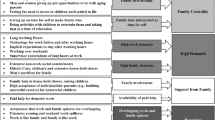Abstract
The unstable, even precarious labor conditions of many frontline service jobs in the United States should render them undesirable to upwardly mobile young workers. Yet for many, these types of jobs complement, rather than infringe upon, their broader lifestyles. Drawing on six years of ethnographic research in upscale Los Angeles restaurants, I show how front-of-the-house service workers navigate portfolio lives—sustained though shifting arrangements of labor and leisure that blur the boundaries between the two. I describe how these workers, who are mostly young, white, and college educated, leverage both personal resources and workplace structures to weave their restaurant jobs into their larger webs of activities. I close by discussing how the concept of portfolio lives extends theories of boundaryless work careers to the urban service economy, though these dynamic assemblages remain subject to class and race inequalities.
Similar content being viewed by others
Notes
Because of my position as a server, my data is slightly skewed toward the perspective of other servers, as opposed to other kinds of front-of-the-house workers.
All informants are referred to using pseudonyms. I also conducted over thirty additional interviews with back-of-the-house workers and managers as a part of a larger research project.
Ray (2018: Chapter 6) argues that the “haphazard” and part-time employment of marginalized urban youth contributes to their inability to rise beyond the “service class” and into better jobs.
By contrast, back-of-the-house service workers at each restaurant were primarily Latino immigrants with low levels of formal education. I take up a systematic comparison of front-of-the-house and back-of-the-house workers elsewhere (Wilson 2017).
References
Adler, Patricia, and Peter Adler. 2004. Paradise laborers: Hotel work in the global economy. Ithaca: Cornell University Press.
Arthur, Michael B., and Denise M. Rousseau, eds. 1996. The boundaryless career: New employment principle for a new organizational era. New York: Oxford University Press.
Ashton, Daniel. 2015. Creative work careers: Pathways and portfolios in the creative economy. Journal of Education and Work 28 (4): 388–406.
Bailey, Catherine, and Adrian Madden. 2017. Time reclaimed: Temporality and the experience of meaningful work. Work, Employment, and Society 31 (1): 3–18.
Barley, Stephen, and Gideon Kunda. 2004. Gurus, hired guns, and warm bodies: Itinerant experts in a knowledge economy. Princeton: Princeton University Press.
Bernhardt, Annette, Martina Morris, Mark Handcock, and Marc A. Scott. 2001. Divergent paths: Economic mobility in the new American labor market. New York: Russell Sage Foundation.
Besen, Yasemin. 2006. Exploitation or fun? The lived experience of teenage employment in suburban America. Journal of Contemporary Ethnography 35 (3): 319–340.
Besen-Cassino, Yasemin. 2014. Consuming work: Youth labor in America. Philadelphia: Temple University Press.
Bielby, William, and Denise Bielby. 1999. Organizational mediation of project-based labor markets: Talent agencies and the careers of screenwriters. American Sociological Review 64 (1): 64–85.
Blau, Peter, and Otis Duncan. 1967. The American occupational structure. New York: Wiley.
Bourdieu, Pierre. 1984. Distinction: A social critique of the judgment of taste. Cambridge: Harvard University Press.
Cobble, Dorothy. 1991. Dishing it out: Waitresses and their unions in the twentieth century. Chicago: University of Illinois Press.
Cohen, Laurie, and Megan Mallon. 1999. The transition from organizational employment to portfolio working: Perceptions of “boundarylessness”. Work, Employment, and Society 31 (1): 3–18.
Côté, James, and John Bynner. 2008. The transition to adulthood in the UK and Canada: The role of structure and agency in emerging adulthood. Journal of Youth Studies 11 (3): 251–268.
Elcioglu, Emine F. 2010. Producing precarity: The temporary staffing agency in the labor market. Qualitative Sociology 33: 117–136.
Erickson, Karla. 2009. The hungry cowboy: Service and community in a neighborhood restaurant. Jackson: University of Mississippi Press.
Fleming, Peter, and Andrew Sturdy. 2011. ‘Being yourself’ in the electronic sweatshop: New forms of normative control. Human Relations 64 (2): 177–200.
Frenette, Alexandre. 2013. Making the intern economy: Role and career challenges of the music industry intern. Work and Occupations 40 (4): 364–397.
Frenette, Alexandre, and Richard Ocejo. 2016. Sustaining enchantment: How culture workers manage precariousness and routine. Research in the Sociology of Work.
Gatta, Mary, Heather Boushey, and Eileen Appelbaum. 2009. High-touch and here-to-stay: Future skills demands in US low wage service occupations. Sociology 43 (5): 968–989.
George, Molly. 2008. Interactions in expert service work: Demonstrating professionalism in personal training. Journal of Contemporary Ethnography 37 (1): 108–131.
Gomberg-Muñoz, Ruth. 2011. Labor and legality: An ethnography of a Mexican immigrant network. New York: Oxford University Press.
Granovetter, Mark. 1974. Getting a job: A study of contacts and careers. Cambridge: Harvard University Press.
Grugulis, Irene, and Odül Bozkurt, eds. 2011. Retail work. New York: Palgrave Macmillan.
Halpin, Alex. 2015. Subject to change without notice: Mock schedules and flexible employment in the United States. Social Problems 0: 1–20.
Ham, Julie, and Fairleigh Gilmour. 2017. ‘We all have one’: Exit plans as a professional strategy in sex work. Work, Employment and Society 31 (5): 748–763.
Hochschild, Arlie. 1983. The managed heart: The commercialization of human feeling. Los Angeles: University of California Press.
Huddleston, Prue. 2011. “It’s all right for Saturdays, but not forever”: The employment of part-time student staff within the retail sector. In Retail work, eds. Irene Grugulis and Odül Bozkurt, 109–127. New York: Palgrave Macmillan.
Hughes, Everett. 2009. [1971]. The sociological eye: Selected papers. New Brunswick: Transaction Inc.
Kalleberg, Arne L. 2009. Precarious work, insecure workers: Employment relations in transition. American Sociological Review 74: 1–22.
Kalleberg, Arne L. 2011. Good jobs, bad jobs: The rise of polarized and precarious employment systems in the United States, 1970s–2000s. New York: Russell Sage Foundation.
Khan, Shamus R. 2012. The sociology of elites. Annual Review of Sociology 38: 361–377.
Lloyd, Richard. 2010. Neo-bohemia: Art and commerce in the postindustrial city. 2nd ed. New York: Routledge.
Macdonald, Cameron, and Carmen Sirianni. 1996. Working in the service society. Philadelphia: Temple University Press.
Marshall, Gordon. 1986. The workplace culture of a licensed restaurant. Theory, Culture & Society 3 (1): 33–47.
Mears, Ashley. 2015. Working for free in the VIP: Relational work and the production of consent. American Sociological Review 80 (6): 1099–1122.
Menger, Pierre-Michel. 1999. Artistic labor markets and careers. Annual Review of Sociology 25: 541–574.
Moss, Philip, and Chris Tilly. 2001. Stories employers tell: Race, skill, and hiring in America. New York: Russell Sage Foundation.
Neff, Gina, Elizabeth Wissinger, and Sharon Zukin. 2005. Entrepreneurial labor among culture producers: “Cool” jobs in “hot” industries. Social Semiotics 15 (3): 307–334.
Newman, Katherine. 1999. No shame in my game: The working poor in the inner city. New York: Knopf.
Newman, Katherine. 2006. Chutes and ladders: Navigating the low-wage labor market. Cambridge: Harvard University Press.
Nickson, Dennis, Chris Warhurst, Anne Witz, and Anne Marie Cullen. 2001. The importance of being aesthetic: Work, employment and service organization. In Customer Service, eds. A. Sturdy, I. Grugulis, and H. Willmott, 170–190. Basingstoke: Palgrave.
O’Mahony, Siobhan, and Beth Bechky. 2006. Stretchwork: Managing the career progression paradox in external labor markets. Academy of Management Journal 49 (5): 918–941.
Ocejo, Richard. 2017. Masters of craft: Old jobs in the new urban economy. Princeton: Princeton University Press.
Oppenheimer, Valerie, and Matthew Kalmijn. 1995. Life-cycle jobs. Research in Social Stratification and Mobility 14: 1–38.
Osterman, Paul. 1980. Getting started: The youth labor market. Cambridge: MIT Press.
Pettinger, Lynne. 2004. Brand culture and branded workers: Service work and aesthetic labour in fashion retail. Consumption Markets & Culture 7 (2): 165–184.
Platman, Kerry. 2004. “Portfolio careers” and the search for flexibility in later life. Work, Employment, and Society 18 (3): 573–599.
Ray, Ranita. 2018. The making of a teenage service class: Poverty and mobility in an American city. Berkeley: University of California Press.
Restaurant Opportunity Centers United. 2014. The great service divide: Occupational segregation and inequality in the US restaurant industry. Restaurant Opportunities Centers United.
Ross, Andrew. 2009. Nice work if you can get it: Life and labor in precarious times. New York: New York University Press.
Sherman, Rachel. 2011. The production of distinctions: Class, gender, and taste work in the lifestyle management industry. Qualitative Sociology 34: 201–219.
Sherman, Rachel. 2007. Class acts; Service and inequality in luxury hotels. Berkeley: University of California Press.
Tannock, Stuart, and Sara Flocks. 2003. “I know what it’s like to struggle”: The working lives of young students in an urban community college. Labor Studies Journal 28: 1–30.
Terkel, Studs. 1974. Working. New York: New Press.
Topel, Robert, and Michael Ward. 1992. Job mobility and the careers of young men. Quarterly Journal of Economics 107 (2): 439–479.
Umney, Charles, and Lefteris Kretsos. 2015. “That’s the experience”: Passion, work precarity, and life transitions among London jazz musicians. Work and Occupations 42 (3): 313–334.
Waldinger, Roger, and Michael Lichter. 2003. How the other half works. Berkeley: University of California Press.
Warhurst, Chris, and Dennis Nickson. 2009. “Who's got the look?” emotional, aesthetic and sexualized labor in interactive services. Gender, Work and Organization 16 (3): 385–404.
Williams, Christine, and Catherine Connell. 2010. “Looking good and sounding right”: Aesthetic labor and social inequality in the retail industry. Work and Occupations 37: 349–377.
Willis, Paul. 1978. Learning to labor: How working-class kids get working-class jobs. London: Routledge.
Wilson, Eli. 2016. Matching up: Producing proximal service in a Los Angeles restaurant. Research in the Sociology of Work 29: 99–124.
Wilson, Eli. 2017. Serving across the divide: Race, class, and the production of restaurant service in Los Angeles. Doctoral dissertation. University of California, Los Angeles.
Wolkowitz, Carole. 2006. Bodies at work. London: Sage.
Zukin, Sharon. 1995. The culture of cities. Oxford: Blackwell.
Acknowledgements
In addition to several anonymous reviewers who reviewed this manuscript, I would like to thank Alexandre Frenette, Claudio Benzecry, Michael Siciliano, Ruben Hernandez-Leon, Kyle Nelson, and the UCLA Ethnography Working Group for helpful feedback on previous versions of this paper. I would like to acknowledge the Institute for Research on Labor and Employment for funding support on this research.
Author information
Authors and Affiliations
Corresponding author
Additional information
Publisher’s Note
Springer Nature remains neutral with regard to jurisdictional claims in published maps and institutional affiliations.
Rights and permissions
About this article
Cite this article
Wilson, E.R. Managing Portfolio Lives: Flexibility and Privilege Amongst Upscale Restaurant Workers in Los Angeles. Qual Sociol 42, 321–336 (2019). https://doi.org/10.1007/s11133-019-09420-4
Published:
Issue Date:
DOI: https://doi.org/10.1007/s11133-019-09420-4




